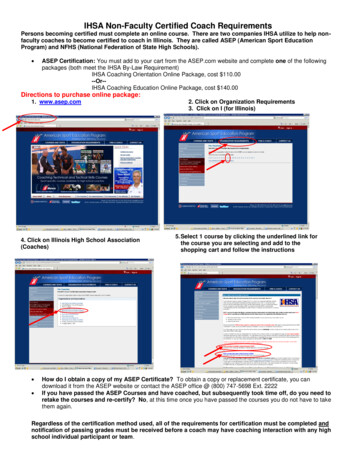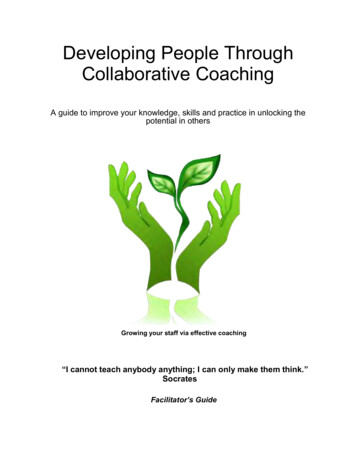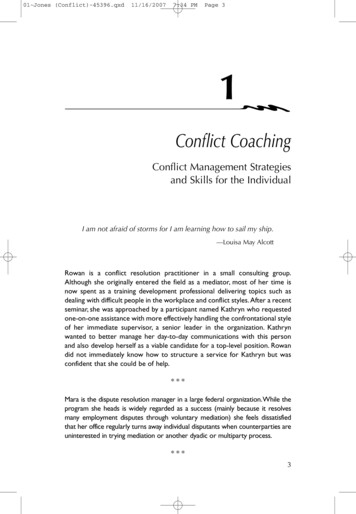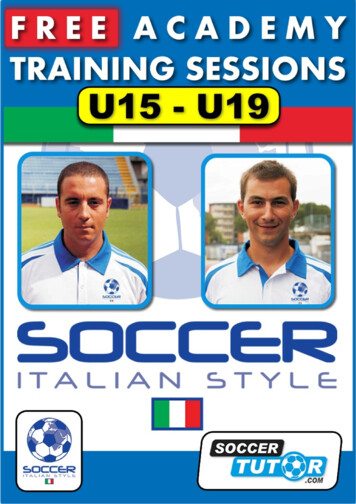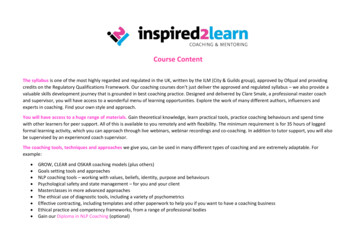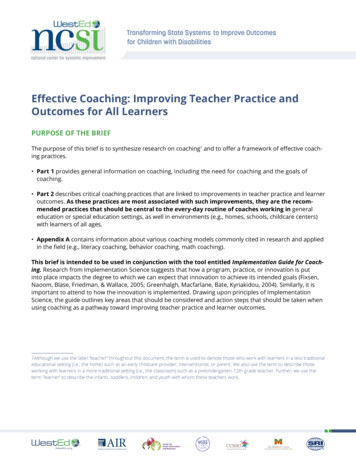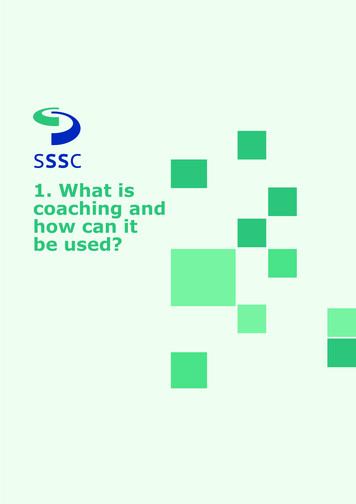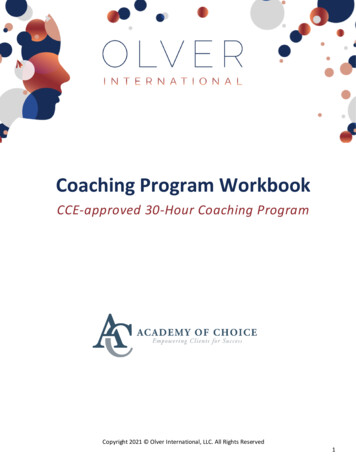
Transcription
Coaching Program WorkbookCCE-approved 30-Hour Coaching ProgramCopyright 2021 Olver International, LLC. All Rights Reserved1
ContentsWelcome Letter.4What is the Difference between Coaching, Counseling, and Consulting? .5BCC Code of Ethics .6Considerations in Coaching.8Issues in Coaching .9The Five Basic Needs . 11Essential Coaching Skills . 13Coach Characteristics . 15Types of Coaching Questions . 19Role Coach vs. Role of Client . 23Coach Coaching Model . 24The Elements of an Effective Plan . 29Relationship Habits . 31Identification of Client Resources . 32Decision-Making Model. 34Self-Sabotage . 35Affirmations Checklist . 36Perception Shifting Worksheet . 37Organizational Roles . 38Sample Corporation Organization Chart . 39Sample Sole Proprietor Organizational Chart . 39Sample Flat Organizational Chart. 40Conditions of Quality. 43Conditions of Quality Checklist . 44Creating Systemic Change . 46Resistant Employees . 47Circles of Control . 48Triangle of Choice . 49Get the Knot Over Your Dot . 50Solving Circle . 51Some Coaching Assessments . 52Copyright 2021 Olver International, LLC. All Rights Reserved2
The Johari Window . 54Four Stages of Competence . 55Assessing Client Motivation Prochaska & DiClementi’s Stages of Change . 56Self-Assessment of Basic Needs . 57Pete’s Pathogram. 59Other Assessment Considerations . 61Factors that Could Influence the Coaching Process. 62Practice Considerations . 63Self-Evaluate. 64Maintaining your Credential . 65Scenarios for Skills Practice. 66Reflection and Review. 70Coach Coaching Evaluation . 78Copyright 2021 Olver International, LLC. All Rights Reserved3
Welcome LetterDear Choice Coach,We at Academy of Choice know you have many options when choosing the right coaching program for you and arepleased and honored that you chose us! We have a wonderful program in store for you that will not only help youlearn what we suspect will be on the national BCC exam, but will also provide you with essential coaching skills,along with our proprietary system of Choice Coaching, where you teach your clients to be bigger than anything thathappens to them.This workshop was designed to accompany our live, in-person training. The face-to-face content of this program willconsist of 30 contact hours.While you are taking this workshop, we want you to process the information on two levels – first, learn the conceptsas they relate to your life. We hope you will apply the Choice Coaching Principles to your daily living to help youenrich it, while at the same time providing an example for your clients of what Choice Coaching can do for a person.Secondly, you will learn these concepts as a method of helping your clients apply Choice Coaching in their lives. Youwill be able to coach others without applying these concepts to your own life, but personal integration will causeyou to be so much more effective so we hope you will begin that journey.You chose the in-person program, but we also want you to have access to our Facebook community to interact withothers who are taking the distance learning program if you choose. Simply create a Facebook account if you don’talready have one. It’s free. If you are concerned about your privacy, you can create a fictitious name to use only atAcademy of Choice. Once you have your account, go to www.facebook.com/kimolver and send me a friend request.I will accept and then add you to the private Academy of Choice group where you will have access to our othercoaching students.The Academy of Choice also offers coaching for coaches s/coaching/), as well as supervision es/supervision/)if you ever find yourself in need of those services.Your participation at Academy of Choice entitles you to one-month free with Coaching Websites. If you want themto create your website and host it for you, you only have to use promo code “1FREE” and you will get your websitedeveloped and one month hosting for free.Get ready for a highly exciting, fun, concentrated learning experience. Ready?Open Your Heart, Free Your Mind &Transform Your Life!Kim OlverPhone: 708-957-6047Fax: fChoice.comCopyright 2021 Olver International, LLC. All Rights Reserved4
What is the Difference between Coaching, Counseling, andConsulting?Coaching: As stated by the Board Certified Coach; coaching is assessing the needs of clients, collaboratewith clients on solutions, and offer strategies that assist individuals and organizations in reaching identifiedgoals. SportLifeJobWeight LossManagerLawyerTutorTeacherCounseling: As stated by the Merriam-Webster Dictionary: counseling is professional guidance of theindividual by utilizing psychological methods especially in collecting case history data, using varioustechniques of the personal interview, and testing interests and aptitudes. Mental HealthChristianCareerCreditGriefDrug and AlcoholSchoolMarriageConsulting: A consultant as described in the book, Getting Started in Personal & Executive Coaching, issomeone who is the expert that give the client direct answers to specific problems and who has all theright answers. dicineHuman ResourcesEconomicsCopyright 2021 Olver International, LLC. All Rights Reserved5
BCC Code of EthicsThe Board of Certified Coaches has ethics as does any organization. The following are the ethics to befollowed as a Certified Coach.These ethical standards can be found deofethics.pdfSECTION A: COMPLIANCE WITH LEGAL REQUIREMENTS AND CONDUCTSTANDARDSBCC certificants and applicants shall:1. Comply with all applicable laws and governmental regulations relating to occupational activities.2. Refrain from conduct or behavior that is contrary to legal or regulatory requirements.3. Refrain from behavior involving dishonesty or fraud.4. Refrain from unlawful discrimination in occupational activities, including age, race, gender, ethnicity, sexualorientation, gender orientation, religion, national origin or disability.5. Avoid condoning or engaging in harassment, including deliberate or repeated unwelcomed comments,gestures or physical contact.6. Maintain accurate records related to the coaching relationship for a period of five (5) years. Records mustinclude current data identifying the client and sponsor; fees schedule and payment documentation;coaching service agreement; purpose and goals of services; progress notes; referrals made; and date ofcoaching relationship termination. At the conclusion of the five year record maintenance period,certificants and applicants may dispose of coaching records in a manner that protects client privacy.7. Disclose to appropriate governmental agencies and sponsors when a client appears to be a danger to or isotherwise unable to act safely concerning self or others. Such disclosures shall be consistent with thecoaching service agreement as well as legal and occupational requirements.SECTION B: COMPLIANCE WITH CCE ORGANIZATIONAL POLICIES AND RULESBCC certificants and applicants shall:1. Comply with all applicable CCE policies and procedures, including the BCC Code of Ethics and CCE Ethics CaseProcedures, as amended or revised.2. Provide accurate information to CCE.3. Maintain the security of confidential CCE information and materials, including examination materials.4. Cooperate with CCE concerning ethics matters, including the collection of information.5. Inform and support others, such as employers, sponsors or coaches, regarding the responsibilities establishedby this Code.6. Report an apparent violation of the BCC Code of Ethics by a certificant or an applicant upon a factual basisCopyright 2021 Olver International, LLC. All Rights Reserved6
SECTION C: PERFORMANCE OF SERVICES AND OTHER OCCUPATIONALACTIVITIESBCC certificants and applicants shall:1. Conduct all occupational activities in a responsible manner.2. Recognize the limitations of coaching practice and qualifications, and provide services only when qualified.Certificants and applicants are responsible for determining the limits of their competency based oneducation, knowledge, skills, experience, credentials and other relevant considerations.3. Protect the privacy of information obtained in the course of providing services, including electronic files andcommunications. Certificants and applicants shall not disclose this information unless authorized to do soby applicable legal requirements, client authorization or the written coaching agreement. The limits ofprivacy shall be clearly identified before coaching services begin.4. Properly use occupational credentials, titles and degrees; and provide accurate information con cerningeducation, experience, qualifications and the performance of services.5. Avoid coaching techniques that are harmful or have been shown to be ineffective. Certificants and applicantsare responsible for ensuring that the techniques used are consistent with clients’ emotional, intellectualand physical needs. Certificants and applicants shall inform clients regarding the purpose, application andresults of the techniques, assessments and strategies.6. Obtain a written coaching service agreement before initiating a coaching relationship. This agreement shallinclude the rights, roles and responsibilities of the parties involved, as well as the manner in which privateinformation will be protected.7. Seek supervision from qualified professionals when necessary, and provide referrals when unable to provideappropriate assistance to a client as well as when terminating a service relationship.8. Ensure that clients, sponsors and colleagues understand that coaching services are not counseling, therapy orpsychotherapy services, and avoid providing counseling, therapy and psychotherapy.SECTION D: AVOIDANCE OF CONFLICTS OF INTEREST AND THE APPEARANCE OFIMPROPRIETYBCC certificants and applicants shall:1. Disclose to others, including sponsors, clients or colleagues, significant circumstances that could be construedas a potential or real conflict of interest, or any having an appearance of impropriety.2. Avoid conduct that could cause a conflict of interest regarding clients or sponsors. If a conflict of interestoccurs, certificants and applicants shall take reasonable steps to resolve the conflict.3. Avoid engaging in multiple relationships with clients or sponsors. In situations where multiple relationshipscannot be avoided, certificants and applicants shall discuss the potential effects of the relationships withthe affected individuals and shall take reasonable steps to avoid any harm. This discussion should also benoted in the client’s record.4. Avoid sexual or romantic relationships with current clients. Certificants and applicants shall not engage insexual or romantic interactions with former clients for a minimum of two (2) years following the date oftermination.5. Refrain from offering or accepting significant payments, gifts or other forms of compensation or benefitsoutside of the written coaching service agreement.6. Acknowledge accurately the intellectual property of others with respect to all activities.Copyright 2021 Olver International, LLC. All Rights Reserved7
Considerations in Coaching Adhere to BCC Code of Ethics Obtain coachee agreement on thenature & limits of coaching Obtain agreement on the process ofconfidentiality in coaching Apply standards of practice in coaching Establish and maintain trust & mutualrespect Establish & maintain confidentiality forvirtual coaching Operate within the coachee’s ethicalsystem without violating coach’s owncode of ethics Inform coachee about legaldimension of the coachingrelationshipClarify roles and responsibilities insharing data prior to assessmentID any dual relationship issues thatcould influence the coaching process Inform coachees of ethical standardsof coaching Explain coach and coachee roles incoaching Explain coaching processes tocoachee Maintain a physically safe environmentfor service provisionObtain agreement on theparameters of confidentiality incoaching Agree to accessibility protocols Maintain appropriate coachee casenotes and records Practice liability risk management Obtain authorization for release ofcoachee informationCopyright 2021 Olver International, LLC. All Rights Reserved8
Issues in CoachingDual Roles/RelationshipsCounseling versus CoachingUsing non-directive techniques all the timeGuru versus CoachClient’s not ready to make changesClient not taking personal responsibilityCopyright 2021 Olver International, LLC. All Rights Reserved9
Client who is stuck in the pastWorking harder than the clientValues conflictPersonality conflictFinding SupervisionProfessional Organizations/EducationCoaching Session Mediums: via phone, email, in-person, ZoomCopyright 2021 Olver International, LLC. All Rights Reserved10
The Five Basic NeedsSAFETY & SECURITYCONNECTIONSIGNIFICANCEFREEDOMJOYCopyright 2021 Olver International, LLC. All Rights Reserved11
SUMMARY1. These needs are written into our genetic instructions.2. You can’t make one more important to you than the others. The strength of each need isdetermined through our genetic wiring. For example, you can’t decide you don’t like the fact yourconnection need is the highest and somehow work to make it less important. Your need strengthsare what they are.3. Sometimes when one is frustrated, you will perceive it as the most important but this is just until itssatisfied. Then it goes back to the genetically-programmed level.4. You feel best when you are getting the precise amount of each need that you want. Not gettingenough leaves you feeling deprived and getting too much can leave you feeling over-saturated.5. You never go out to directly “meet your needs.” You have a picture in your head, in your perfectvision that you believe will feel good. You go after this vision and when you accomplish a part of it,it feels good and consequently meets at least one or more of your needs.6. The only time it’s really important to understand what need or needs a person is trying to meet iswhen they can’t have the thing they want. Their perfect vision is not available to them, it’s notavailable now, or the consequences are too great. When this happens, you want to uncover thelargest unmet need so you can help your client get more of what they need when they can’t havewhat they truly want. The Rolling Stones sang it best . . . “You can’t always get what you want but ifyou try sometimes, you just might find, you get what you need.”Copyright 2021 Olver International, LLC. All Rights Reserved12
Essential Coaching SkillsCreating a Safe EnvironmentUnconditional Positive Regardo Building Rapport Eye Contact Mirroring Finding commonalities Find something to like about your cliento Active & Reflective Listeningo Being Nonjudgmentalo Acceptanceo Using Caring Habitso Appreciating Differenceo Observe Confidentiality and explain its limitationso Avoid Arguing, Criticizing, and Blamingo Cultural Competenceo Be Genuineo Model your approach (InsideOut Empowerment )o Help clients recognize and identify their strengthso Focus on a client’s progress, rather than lack of progresso Accurately assess client motivationo Discriminate between perceptions that are helpful and those that aren’t, while assistingclients to transform the unhelpful ones to helpfulo Demonstrating the correct balance between support and challenge\Organizingo Gathering information What is/are their goal(s)? What have they done to obtain their goal so far? What worked and has not worked in trying to obtain their goal? What has been stopping them from achieving their goal? When do they want to achieve their goal by? Helps client recognize the benefits in seemingly “negative” situationsCopyright 2021 Olver International, LLC. All Rights Reserved13
Goal SettingooooooSimpleMeasureableAttainableMakes sure the plan is the client’sProvide client with at least three optionsFollow the 9 Elements of an Effective PlanProviding FeedbackooooAsks effective self-evaluation questions.Help clients focus on the areas that required attentionNonjudgmentalDid they achieve their goal? If not, what stopped them from achieving their goal? Hold clients accountable for the commitments they make Go back to go setting If yes, what is the next step? Go back to goal setting or if final step terminationCopyright 2021 Olver International, LLC. All Rights Reserved14
Coach Characteristics EmpathyNon-judgmental in the coachingprocessCompassionHonest & straightforward gLinking ProcessParaphrasingSummarizingEncouragementActive ListeningReframingHumorUse MetaphorsUse AmbiguityOffer insightInterpret Nonverbal CommunicationUse immediate interactions to advance the coaching processUse appropriate reinforcement techniquesChallenge coachee to move beyond their comfort zoneGenerate possibilities and brainstormCopyright 2021 Olver International, LLC. All Rights Reserved15
Model CreativitySelf-awarenessAcceptanceEffective interpersonal communicationThe acceptance of a challengeSelf-disclosureFlexibility in coachee goal revisionAssist Clients To: Understand their current perspectiveGain new perspectivesUnderstand their belief and value systems that impact goalsAdapt and modify their belief and value systems to achieve their goalsUnderstand balance of life roles in careers, while discussing work/life balanceUnderstand potential risks in decision-making and develop strategies to minimize risksIdentify, develop and use appropriate support systemsAssist the coachee in locating relevant information and resourcesManage role transitionsBuild skillsBuild confidenceManage conflictMove from awareness to actionIdentify relevant life experiencesTake action based on dataCreate a personal action planSet short-and long-term goalsClarifying goal(s)Identify potential strategies for meeting goalsCopyright 2021 Olver International, LLC. All Rights Reserved16
Copyright 2021 Olver International, LLC. All Rights Reserved17
Copyright 2021 Olver International, LLC. All Rights Reserved18
Types of Coaching QuestionsAffective questions:Analytical questions:Connecting questions:Clarifying questions:Reflective questions:Open-ended questions:Exploratory questions:Copyright 2021 Olver International, LLC. All Rights Reserved19
Probing questions:Challenging questions:Copyright 2021 Olver International, LLC. All Rights Reserved20
Copyright 2021 Olver International, LLC. All Rights Reserved21
Copyright 2021 Olver International, LLC. All Rights Reserved22
Role Coach vs. Role of ClientRole of the CoachRole of the ClientHelp clients clarify what they wantHelp clients develop a vision of where they want togoHelp clients discover and develop their missionand passionAssist clients with determining their mostimportant values in rank orderAssist clients with identifying what they havealready done and give credit for what’s alreadybeen accomplishedCreate a celebration and anchor of successesAssess skill level and abilities. Recommend neededskill acquisition.Assist clients in self-evaluating their progress thusfar with honesty and accuracyAssist clients in developing future goalsHelp clients break those goals down intomanageable stepsTogether with clients anticipate and plan forpossible obstacles to successGet commitments from clients on next actionablestepsAssess progress and give credit for all that wasdone instead of focusing on what wasn’tHold clients accountable for the agreements theymakeAssist clients in making adjustments to their plansas neededSupport clients through difficult timesDo not accept excusesMaintain the proper balance of support andchallenge depending on client needSeek clarity on what they wantDevelop a vision of where they want to go andwhat they wish to accomplishGet in touch with one’s passion and create a fluidmission statementEngage in value-clarification process and allowthose values to guide the decision-making processDo a thorough inventory of what they have alreadygone to prepare for and move in the direction ofwhat they wantLearn to celebrate and anchor successDetermine what deficits exist in the education/skilldepartment and make plans to close that gapLearn to self-evaluate with integrityHelp client uncover self-sabotage through skillfullyasked questionsTeach clients the Triangle of Choice—change theirwants, behavior, or perceptionsDevelop future goalsBreak goals down into manageable stepsAnticipate and plan for possible obstacles tosuccessMake commitments on actionable steps. Make it astretch and challenge but definitely doable.Make progress on your action items and focus onthat progressHonor any and all agreements you make with yourcoachBe attentive to your course and flexible so you canmake adjustments as neededDon’t give upDon’t make excusesUse your coach when you need help, celebratewith him or her when you are successful and mostof all, use your coach when you need inspirationOpenly and honestly examine any situations inwhich there may be self-sabotageLearn and enact the Triangle of Choice by changingwhat you want, your behavior or your perceptionCopyright 2021 Olver International, LLC. All Rights Reserved23
Coach Coaching ModelPrinciplesThe only person’s behavior you can control is your own.Others may attempt to heavily influence your behavior,but the choice is ultimately yours.Whatever happens in the outside world has nomeaning other than the meaning you give it. You havethe power to change the meaning you assign frompositive to negative, negative to positive, or frompositive or negative to neutral.Every behavior you choose, including your feelings, isdesigned to get you something you want. It is alwaysproactive; never reactive, except for instinctualresponses, for example sneezing, the startle response,or crying in response to pain.What you want is based on what feels good (increasingpleasure or avoiding pain). Sometimes people are ableto give up what would feel good right now forsomething that will feel even better later buteverything you do is designed to get you closer toincreased positive feelings.When you are unhappy about the conditions of yourlife, you should first clarify specifically what you wantrather than focusing on what you want to avoid. Then,ask for what you want but if you don’t get what you askfor, in order to find a peaceful resolution, you musteither change what you are doing, change what youwant, or change your perception. Of course, if you wantto stay in your misery, you don’t have to changeanything at all. You can always stay unhappy if thatworks for you. It’s your choice.Much of our health, both physical and emotional, isstrongly affected by our actions and our thoughts, bothof which we have the power to change. If you don’t likethe emotions you are experiencing or your currentstate of health, you can indirectly affect change bychanging your actions and/or your thinking.People often see their choices as either/or choices,instead of opening the possibilities of combining themany things we want, creating imagined dilemmas andforced choices. You can greatly increase your power byasking, “How can I do both?” For example, how can Ireduce my credit card debt and still buy things on aCoaching GoalsUnderstand and take responsibility for their choicesUnderstand the power of their perception and how tochange itFind the balance in all thingsDistinguish and choose between what feels good rightnow and what will feel even better laterExpanding either/or thinking to a both/and approachMake the connection between their behavior and theirprogress or lack thereofUncover their self-sabotage, while learning to minimizeits importanceCopyright 2021 Olver International, LLC. All Rights Reserved24
whim when I want to? Or, how can I lose weight andstill have chocolate?People do not change until the pain of staying the sameexceeds their fear of or discomfort with change.People are frequently being sabotaged by thinking thatis outside of their conscious awareness that was likelyinstalled at a very young age, before they were able todiscriminate between truth and lies. In order toovercome this self-sabotage, you must bring thisthinking to your conscious awareness where it can
as they relate to your life. We hope you will apply the Choice Coaching Principles to your daily living to help you enrich it, while at the same time providing an example for your clients of what Choice Coaching can do for a person. Secondly, you will learn these concepts as a method of helping your clients apply Choice Coaching in their lives. You

